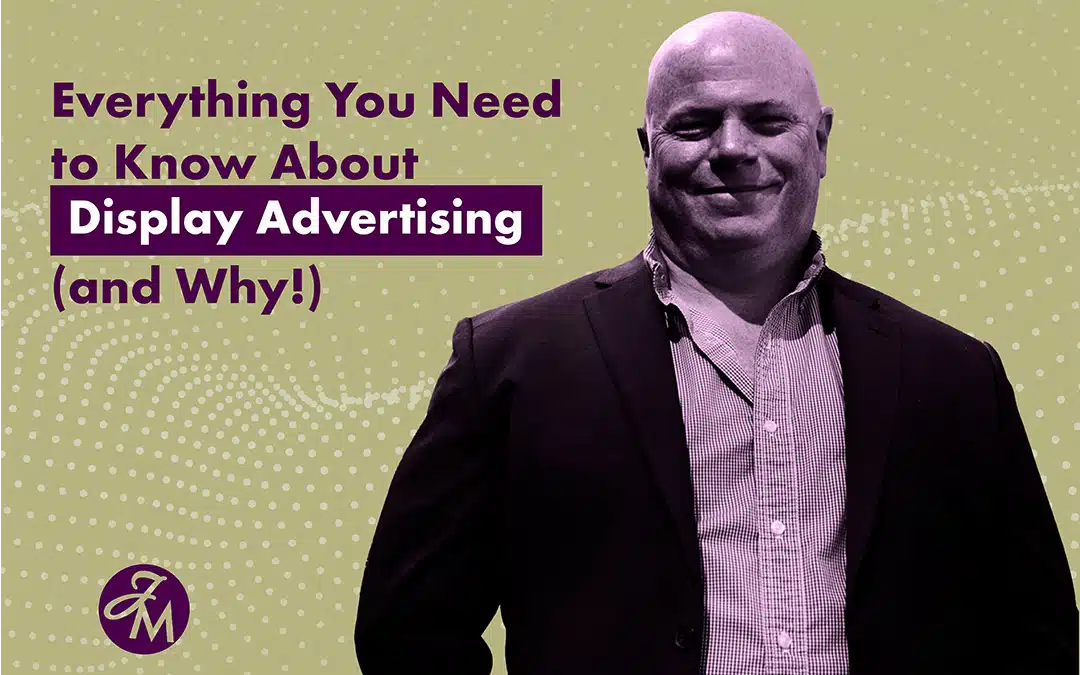You’ve seen them everywhere. Those little visual ads that follow you around the internet. Sometimes they’re annoying, but other times, they seem to read your mind. This is display advertising, and it gets a bad rap.
For years, I’ve watched entrepreneurs either ignore it or throw money at it with no real plan. They think it’s just about flashy banner ads. But good display advertising is so much more; it’s a key part of any modern digital advertising campaign.
It’s about showing up in the right place, at the right time, for the right person. You’ll learn how to make it work for you. Because when you get it right, a display ad can seriously grow your business.
Table of Contents:

- What Are Display Ads Anyway?
- Is Display Advertising a Good Fit for Your Business?
- How Does Display Advertising Actually Work?
- My Playbook for Winning with Display Advertising
- How to Tell if Your Ads Are Making You Money
- Conclusion
What Are Display Ads Anyway?
Let’s get on the same page about what a display ad is. Display ads are the visual advertisements you see on websites, apps, and even social media. Think of them as the billboards of the digital world, but much smarter and more targeted.
These online ads can be static images, animated graphics, or even short video ads. You often spot a banner ad in the headers, footers, or sidebars of a blog you’re reading. Display ads appear in many ad formats, including interactive rich media ads that invite user engagement.
Their main job is to increase brand awareness and reach potential customers wherever they are online. Unlike search ads, which target people actively searching for a solution, display ads reach people while they are browsing other content. This form of advertising captures attention on a host website or within news feeds on social media.
Is Display Advertising a Good Fit for Your Business?
This is the big question, isn’t it? The honest answer depends entirely on your goals for your marketing campaign. I’ve seen it work wonders for some, but it’s not a magic wand for every single company.
Used correctly, though, display ads can be a powerful part of your marketing mix. It can help you reach a large audience that might not find you otherwise. Let me show you how different kinds of brands use them to see it in action.

For Boosting Sales (Like Casper)
Look at an e-commerce brand like Casper. They sell mattresses and sleep products online. Their goal is direct: sell more stuff and increase their market share.
They use a display ad campaign to shout about their limited-time sales and show off glowing customer reviews. Most of their banner ads focus on one specific product, usually tied to a nice discount. It’s a simple, effective way to get shoppers to click and improve their conversion rate.
Interestingly, they buy a lot of their ad space directly from publishers. This placement targeting helps them cut out the middleman and keep their ad spend down. It’s a smart move for brands focused on the bottom line, as direct buys offer control over where ads display.

For Building Brand Awareness (Like ActiveCampaign)
Now, what if you’re a software company like ActiveCampaign? They aren’t always looking for an immediate sale from their ad campaign. A lot of their effort goes into a long-term advertising campaign to increase brand awareness.
They use programmatic advertising, which automatically buys ad space to reach a huge audience. Because their goal is to increase brand visibility, they aren’t as worried about prime ad placement. This approach allows their ads to reach people who may not be familiar with their software yet.
This strategy lets them reach millions of potential customers without breaking the bank. Their cost for every thousand impressions is incredibly low. This is how you play the long game and build recognition over time with a consistent advertising platform.
For Inspiring Action (Like Expedia)

Then you have a giant like Expedia, whose business is selling experiences. Their media ads need to be inspiring and visually compelling. A simple banner ad might not be enough to capture the imagination of a potential traveler.
Expedia uses stunning rich media and video ads of destinations to make you want to book a trip right now. They run thousands of different ad versions to see what works best. This constant A/B test process helps them get more bang for their buck and understand audience preferences.
They spend a lot, which gives them access to great ad spots on popular websites. By mixing direct buys with programmatic ads, they get their beautiful ads in front of people who are ready to dream about a vacation. This blend of tactics is central to their successful digital advertising strategy.
How Does Display Advertising Actually Work?
It might seem complicated from the outside, but buying and selling display advertising usually happens in one of three ways. I’ve used all of them at different times. Each has its place within a broader marketing campaign.
Understanding these targeting methods helps you pick the right path for your budget and goals. Your choice will affect how your ads reach customers. Each method offers different levels of control and reach.
The system works through a collaboration between advertisers, publishers (the websites displaying ads), and ad networks or exchanges. When a user visits a host website, an auction can happen in milliseconds to determine which targeted ad gets shown. This process ensures the most relevant display ad is served to the user.
| Buying Method | How It Works | Best For |
|---|---|---|
| Direct Buy | You negotiate directly with a website for placement targeting. You agree on a price and time frame. | Brands who want guaranteed placement on a specific, relevant site to reach a niche audience. |
| Ad Networks | You use an ad network like the Google Display Network to place ads across many websites. It allows for audience targeting based on interests and user behavior. | Businesses who need wide reach and want to target people based on demographics and online habits. |
| Programmatic Advertising | An automated, auction-based system for buying ads across various advertising platforms. This gives access to a massive inventory of ad spaces. | Advertisers looking to scale ad campaigns with detailed targeting options and real-time control. |
My Playbook for Winning with Display Advertising
Alright, let’s talk strategy. Over the years, I’ve developed a playbook for running display advertising campaigns that don’t just spend money but actually make it. It comes down to a few key areas.
You can’t just create ads and hope for the best. A successful display ad campaign requires a thoughtful approach from start to finish. This plan covers finding your audience, crafting your message, and constant optimization.
Find Your Audience’s Hangout Spots

First things first, where do your potential customers spend their time online? Answering this question is half the battle. You wouldn’t put an ad for retirement planning on a video game forum, would you?
The Google Display Network is the big player here, as its ads reach over 90% of internet users. It’s fantastic for putting your ads in specific contexts using contextual targeting. For example, a fitness brand can choose to only appear on health blogs or YouTube channels about exercise.
If you’re in the B2B space, the Microsoft Audience Network could be your ticket. It lets you place native ads across professional sites like LinkedIn, which appear naturally within the site’s content. For maximum scale, programmatic advertising platforms give you access to nearly limitless ad inventory on various display network partners.
Words and Buttons That Actually Work
You have just seconds to get someone’s attention. This means your words have to be powerful and your call-to-action (CTA) button has to be irresistible. There’s no room for weak copy when people click ads in an instant.
Focus on what the customer gets, not just what your product does. Instead of saying “Our software has a new feature,” try “Grow your revenue by 30%.” Specific numbers can be very persuasive, but make sure you can back them up.
Use clear, action-oriented language like “Get Your Free Trial” instead of something vague like “Learn More.” Creating a little urgency with phrases like “Offer Ends Tonight” can also give people the nudge they need to take action. Effective ads require compelling copy.
Peek at Your Competition’s Homework
You don’t have to reinvent the wheel. Analyzing what your competitors are doing is one of the smartest shortcuts I know. It can tell you what’s working in your industry and what’s a waste of money.
Tools are out there that let you see your competitors’ top-performing ads. You can find out how much they’re spending on their advertising campaigns. You can also discover which websites are sending them the most traffic and which ad network they rely on.
This isn’t about copying them. It’s about learning from their successes and failures to make your own digital advertising even better. Use their strategy as a starting point to find gaps and create something that stands out.
Make Your Ads a Feast for the Eyes
Display ads are visual. This might sound obvious, but you’d be surprised how many businesses use blurry, generic stock photos. Your visuals must be sharp, professional, and align with your brand identity.
Keep your design simple, with one clear focal point. This could be your product, a person’s face, or a bold headline. Your ads should also look like they belong to your brand, using the same colors and fonts as your content marketing materials.
And remember, a ton of people will see your ad on a small phone screen. As studies show, smartphones represent a huge share of ad spend. So, your visuals, including mobile leaderboard ads, must be clear and readable on mobile.

Test, Tweak, and Test Again
The biggest mistake I see is setting an ad campaign and forgetting about it. The best digital marketing professionals are always testing. This is how you turn an average campaign into a high-performing one.
This is called an A/B test. You create two versions of an ad, changing just one thing, like the headline, the image, or the ad format. Then you show each version to a different group of people to see which one performs better.
Before you start, set a clear goal, like improving your click-through rate. And make sure you have a large enough audience for your test to give you reliable results. There are even free tools online, like CXL’s A/B test calculator, that can help you figure out your sample size.
How to Tell if Your Ads Are Making You Money
So, you’ve launched your campaign. How do you know if it’s working? You need to watch your numbers like a hawk and be ready to make changes.
Focusing on the right metrics will tell you the real story of your ad performance. Don’t get lost in vanity numbers that don’t matter. The goal is to understand the impact on your business objectives.
Key Numbers to Watch
Your goals determine which metrics are most important, but here are the big ones. Impressions are how many times your ad was shown. The click-through rate (CTR) is the percentage of people who clicked your ad after seeing it.
The conversion rate tells you how many of those clicks turned into a sale or a signup. Cost per action (CPA) is how much you spent for each conversion. And the most important one of all, return on ad spend (ROAS), shows how much revenue you earned for every dollar you spent.
It’s also useful to track view-through conversions for campaigns meant to increase brand recognition. This metric counts users who saw your ad, didn’t click, but converted later. These ads provide value even without an immediate click.
Finding the Patterns
Data is useless without analysis. Look at your numbers from different angles. Did your ads perform better on mobile or desktop? Which websites sent you the most conversions?
Analyzing these patterns will reveal what you need to adjust. Maybe you need to stop displaying ads on a low-performing site. Or perhaps you should put more ad spend behind certain leaderboard ads that are driving results.
This process of continuous improvement is what separates successful advertisers from everyone else. This ongoing analysis is the core of effective campaign management. It helps you refine your strategy and get better results over time.

Conclusion
So, there you have it. Display advertising isn’t some dark art you can’t figure out. It’s a tool, and like any tool, you just need to learn how to use it properly. It’s about being strategic, creative, and willing to learn from your data.
Stop thinking of display ads as just banner ads. Start seeing them as conversations you can have with future customers all across the web. Ads people see should be relevant and add some value, even if it’s just a fleeting moment of visual interest.
When you approach your display advertising campaign with a plan, it can become a predictable and scalable source of growth. The power of relevant display advertising is in its ability to reach people at scale. Get started, test, learn, and watch your business grow.


